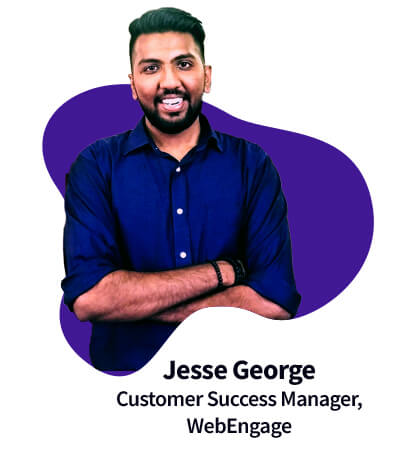Hey Reader, Here is your Tip of the Week from EngageClass! Get better conversions from Google Ads Retargeting with WebEngage
Problem StatementGoogle Ads enable you to remarket via Remarketing Lists for Search Ads (RLSA) along with standard remarketing. But you’re still restricted to campaigns based on user actions. Actions like whether your users have previously visited specific pages of your website/app or not. So, how can you ensure granular targeting and increase your conversions? Don’t worry! We’ve got you covered. 🙂 You can integrate your Google Ads account with WebEngage to create campaigns with more granular targeting. You can use your existing user data to show more personalized ads to different user segments such as cart abandoners, frequent buyers, highest-spending customers, or at risk. How to get better conversions from Google Ads Retargeting with WebEngage?You should first add one (or more) Google Ad accounts on WebEngage. Once done, you can simply create a segment on the WebEngage dashboard or use a pre-existing segment and export it to your chosen Google Ad account. To find out how you can integrate your WebEngage account with Google Ads, read our documentation here. 
Winning strategies for using WebEngage segments for Google AdsShow ads only to users who are most likely to convert 💰You can create a segment of users who have completed some initial action but didn’t follow through to the final conversion (purchase, booking, subscription, etc.). This audience can be sent to Google to have your search ads shown only to them. How does it help? Your budget will last longer than standard search ads because now only the most ‘Qualified’ users will see your ads. Let’s say you run an E-commerce company. You know some of your users have been eyeing a particular Nike sports shoe for the longest time now. These users are probably the most likely to purchase soon. Hence, you can directly export this segment of users who have previously shown interest and show them relevant Nike sports shoe ads (with a discounted price) on Google. 
Recommend related products ✅Users who already have done one or more transactions with your business are likely to purchase related products again. This targeted approach also helps you justify advertising on high-converting products. For example, if you run an automobile business, you might not advertise automobile accessories because they might be low-converting products. But you can advertise to a particular set of users who have already purchased a car from you recently. Such users are more likely to purchase car accessories too. 
Get the freedom to bid on more generic terms, but only for the most qualified users 👥By using highly targeted WebEngage segments as an audience for your ads, you can reduce the risk of bidding on more generic keywords. For example, a retail store that sells Michael Kors bags, but not their watches, might avoid bidding on the term “Michael Kors” because it’s too broad and could be for someone looking for anything under the Michael Kors brand. With WebEngage, you can create a segment of users who have already shown interest in the Michael Kors bags – by either visiting the retail store, visiting the Michael Kors page on the website, or previously engaging with marketing campaigns. The ad will only trigger for these qualified users, thereby helping you make the most of your ad spends. 
Exclude users who have already performed the conversion event 🚫Exclusions are useful while bidding on a brand name or core keywords, where bids usually go very high. Firstly, because you would not want to show these top-of-the-funnel ads to customers as they might be irrelevant to them. Secondly, you might instead try to upsell to them with more targeted ads and justify your budget. To do this, you can create a segment of users who signed up, purchased a product, or performed any conversion event on your platform. You can then export the segment to Google with recurring synchronization to prevent advertising to users that have already converted. 
Bring back inactive users to your platform 📲WebEngage captures the data of your inactive users and even customers who are about to churn. You can create a segment of such users, send them personalized communication, and retain them. You can show a Google ad to these users on a significant product launch, about their unused loyalty points or time-sensitive campaigns, so they act promptly. 
Maximize your margins by targeting discount sensitive users 🆓WebEngage combines data from all your sources to understand your users’ behavior and preferences. Using this data, you can send discount messages only to discount-sensitive buyers, knowing their affinity toward discount rates. 
• • • So, what are you waiting for? Use Google Ads Now
Not integrated your Google Ads account with WebEngage? No problem, we are here to help! 🙂 Please feel free to drop in a few lines at support@webengage.com or get in touch with your Account Manager. Happy Engaging! 
| 
Customer Data Platform
Web Personalization
App Personalization
Product & Revenue Analytics
User Segmentation
 WebEngage AI
WebEngage AI
Campaign Orchestration
Omnichannel Engagement
Impact stories
Blog
eBooks
Academy
Podcast
EngageMint
Newsroom
Events
Knowledge Base
Developer Docs
 Podcast
Podcast Community
Community

















